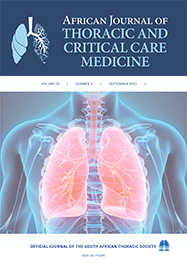Original research

Comparison of outcomes between children ventilated in a non‑paediatric intensive care and a paediatric intensive care unit: A retrospective analysis
Abstract
Background. Lack of paediatric intensive care infrastructure, human resources and expertise in low- and middle-income countries (LMICs) often results in critically ill children being managed in non-intensive-care unit (ICU) settings.
Objectives. To compare the mortality between critically ill patients who required ventilation for more than 24 hours in a non-paediatric ICU (PICU) setting v. those admitted directly to a PICU.
Methods. Participants were enrolled if they were between one month and 13 years of age and were ventilated in a non-PICU ward in a regional hospital and a PICU ward in a tertiary/quaternary hospital during the study period of January 2015 - December 2017 in KwaZuluNatal, South Africa. Descriptive statistics, chi-square test, Wilcoxon test and binary logistic regression were used for data analysis. Ethics approval was obtained (approval number BE568/18 BREC) from the Biostatistics Research Council of the University of KwaZulu-Natal.
Results. Of the 904 admissions, 25.1% (n=227) were admitted to non-PICU and 74.9% (n=677) to a PICU. A significantly higher proportion of non-PICU patients were malnourished than PICU patients (26.4% v. 13.3%, p<0.001). Patients ventilated in a PICU were 76% less likely to die (p<0.001), while patients who required inotropes were 15.08 (9.68 - 24.34) times more likely to die (p<0.001). There was a statistically significant association between admission setting and survival outcome, with higher mortality in the non-PICU setting than in the PICU setting (46.3% v. 19.5%, p<0.001).
Conclusion. Critically ill children ventilated in a non-PICU setting in KwaZulu-Natal are more likely to be malnourished, require inotropes and have higher mortality. Although increasing access to PICU bed availability is a long-term goal, the high mortality in the non-PICU setting highlights the need to optimise the availability of resources in these non-PICU wards, optimise and train the staff, and improve primary healthcare services. Keywords. PICU, non-PICU setting, interim ventilation, outcomes, mortality.
Authors' affiliations
X L Jingxi, Department of Paediatrics and Child Health, School of Clinical Medicine, College of Health Sciences, University of KwaZulu-Natal, Durban, South Africa
P Tinarwo, Department of Paediatrics, King Edward VIII Hospital, Durban, South Africa
R Masekela, Department of Paediatrics and Child Health, School of Clinical Medicine, College of Health Sciences, University of KwaZulu-Natal, Durban, South Africa; Department of Dietetics, King Edward VIII Hospital, Durban, South Africa
M Archary, Department of Paediatrics and Child Health, School of Clinical Medicine, College of Health Sciences, University of KwaZulu-Natal, Durban, South Africa; epartment of Biostatistics, Nelson R Mandela School of Medicine, University of KwaZulu-Natal, Durban, South Africa
Full Text:
Cite this article
Article History
Date published: 2022-09-16
Article Views
Full text views: 136
Refbacks
- There are currently no refbacks.
African Journal of Thoracic and Critical Care Medicine| Online ISSN: 2617-0205
This journal is protected by a Creative Commons Attribution - NonCommercial Works License (CC BY-NC 4.0) | Read our privacy policy.
Our Journals: South African Medical Journal | African Journal of Health Professions Education | South African Journal of Bioethics and Law | South African Journal of Child Health | Southern African Journal of Critical Care | African Journal of Thoracic and Critical Care Medicine| South African Journal of Obstetrics and Gynaecology |



.jpg)